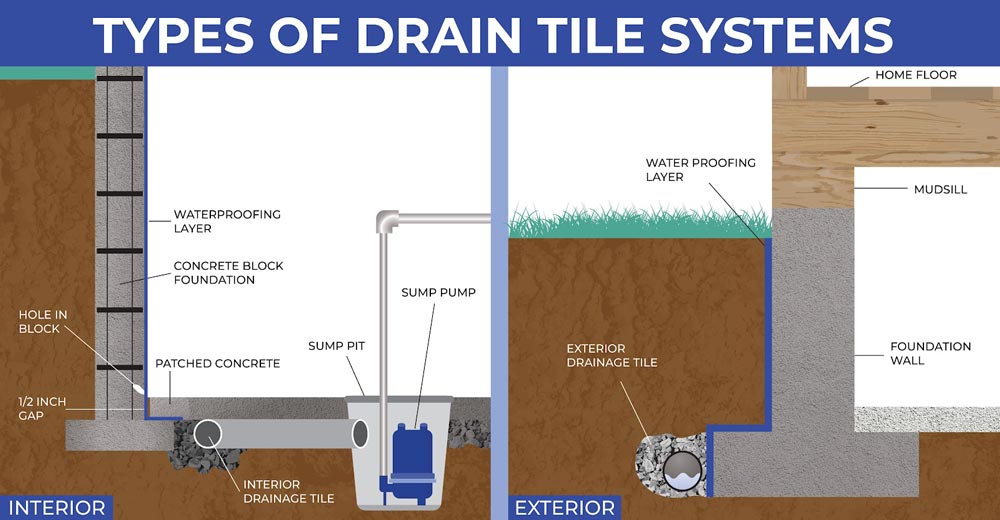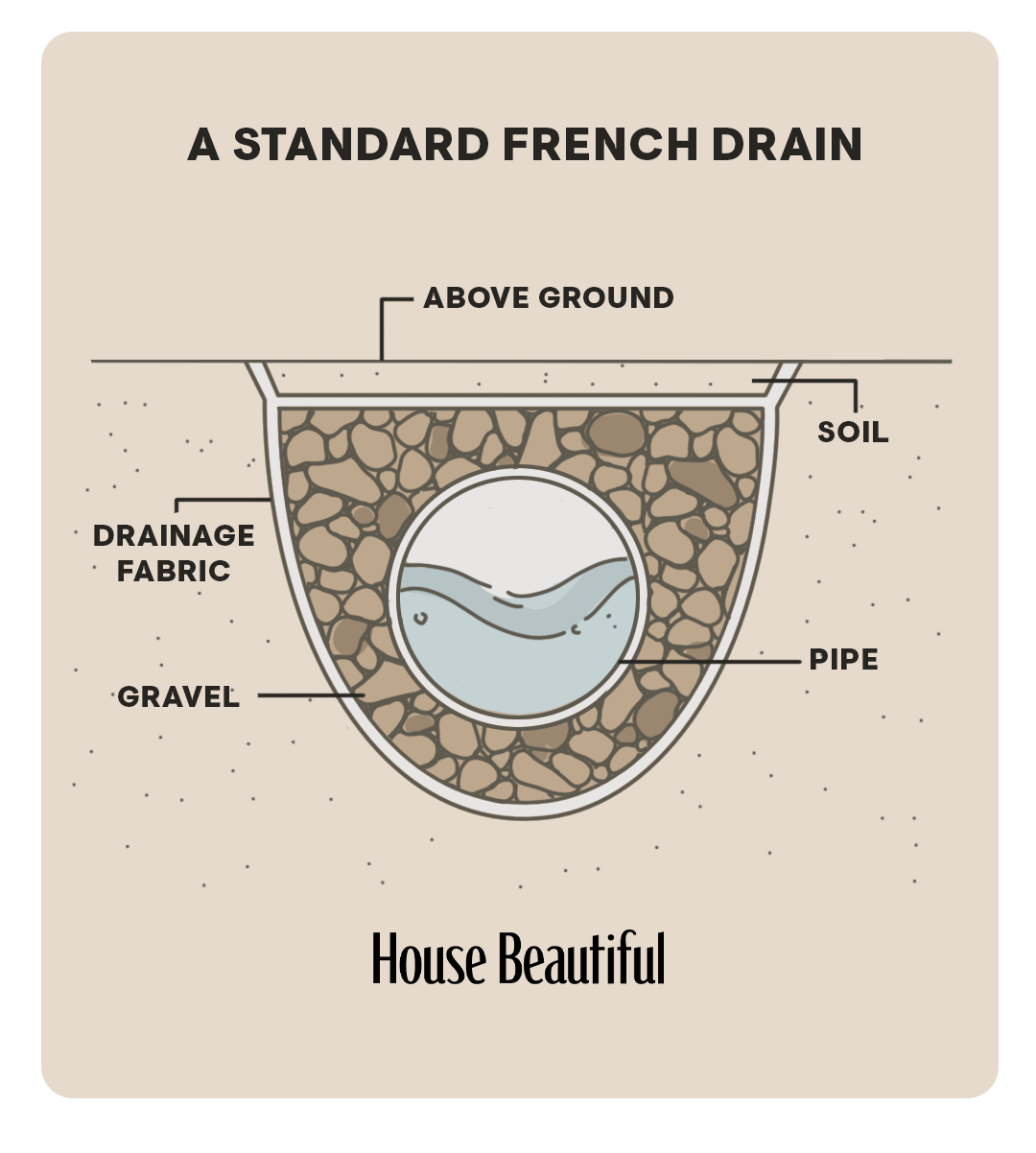Portland French Drain Solutions for Stormwater and Drainage Overflow
Wiki Article
How a French Drainpipe Can Aid Prevent Water Damage in Your Cellar
A French drainpipe may be the remedy you need if you're dealing with a wet basement. This system successfully redirects water far from your foundation, aiding to avoid pricey damages. Recognizing how it functions and identifying the signs that you need one can make a significant difference in your home's security and convenience. Yet prior to you decide, it's vital to discover the advantages and installation process to see if it's the best fit for your circumstanceWhat Is a French Drain?
A French drain is an easy yet efficient option for handling excess water around your residential or commercial property. It's developed to redirect water away from susceptible areas, like your basement or foundation. Generally, it contains a trench full of crushed rock and a perforated pipeline that gathers and channels water. When rainwater or groundwater builds up, the drain efficiently guides it away, preventing potential damage.You might notice French drains pipes mounted along residential or commercial property lines, driveways, and even near your home's foundation. They come in numerous dimensions and arrangements, making them adaptable to different landscapes and drainage needs. Installing a French drain can help you avoid costly repairs and shield your home's architectural stability. If you have actually been handling water pooling or soaked locations in your yard, a French drainpipe might be the solution you need. It's a proactive step to guarantee your property remains risk-free and dry from water-related issues.How Does a French Drainpipe Job?
A French drainpipe kicks into activity to redirect it successfully when water builds up around your property. This system contains a trench full of gravel and a perforated pipeline near the bottom. The pipeline collects excess water from the dirt and networks it away from your foundation.As rain or groundwater seeps right into the gravel, it streams via the openings and into the pipe. Gravity does the job, drawing the water away from your basement and guiding it to a marked drainage area, like a tornado drainpipe or dry well.You can install a French drainpipe either inside or outside your home. If you select an outside configuration, it'll prevent water from merging near your structure. An indoor drainpipe will certainly capture water that seeps with your cellar wall surfaces. This reliable design keeps your area completely dry, permitting you to appreciate your home without the fear of water damage.Benefits of Installing a French Drain
Setting up a French drainpipe can greatly improve your home's resilience against water damage. You'll take pleasure in reliable water diversion, which helps in reducing mold and mildew development and protect your residential property. And also, a properly maintained drainage system can also boost your residential or commercial property's value.Effective Water Diversion

Lowered Mold And Mildew Development
Given that dampness produces a best atmosphere for mold to flourish, reducing water accumulation around your home is essential for keeping a healthy and balanced home. Mounting a French drain properly networks excess water far from your foundation, keeping your basement completely dry. This positive action substantially decreases moisture levels, making it harder for mold and mildew spores to resolve and grow.With much less moisture, you'll find it much easier to take a breath and delight in a clean, secure atmosphere. Plus, you'll reduce the threat of health and wellness issues connected with mold exposure, such as allergic reactions and respiratory troubles. By purchasing a French drain, you're taking an essential action toward a mold-free cellar, guaranteeing that your home remains a comfy place for you and your family members.Enhanced Residential Or Commercial Property Worth
A French drain can substantially increase your property's value, making it a clever investment for homeowners. When prospective customers see a well-kept cellar devoid of water damages, they're most likely to be impressed. This function not just enhances your home's charm yet likewise signifies that you've taken aggressive steps to secure it. By minimizing the risk of water-related issues, your building becomes a lot more eye-catching in an open market, commonly leading to greater deals. Additionally, the long-lasting financial savings on repairs and maintenance can equate right into increased equity. Installing a French drainpipe reveals you appreciate your home's integrity, guaranteeing customers that they're making an audio purchase. Ultimately, it's a useful enhancement that repays in even more ways than one.Signs You Need a French Drainpipe
It's a clear indication that you may need a French drain if you notice persistent water buildup in your backyard or cellar. Furthermore, a moldy odor can show trapped dampness, which can cause bigger problems. Addressing these signs early can aid stop major water damage to your home.
Relentless Water Buildup
It's a clear indication that a French drainpipe may be necessary when you see consistent water accumulation around your home. Water merging near your foundation can Click This Link lead to substantial damage over time, consisting of structural concerns and mold development. You must pay attention to locations where water seems to accumulate after heavy rainfalls or snowmelt. If your lawn remains soggy for days, it's time to act. Furthermore, look for indications of erosion or sloppy patches, as these can show poor water drainage. Installing a French drainpipe helps reroute water away from your home, securing your structure and minimizing the threat of water damage. Do not wait for larger concerns to occur-- resolving water accumulation currently can conserve you costly repair services later on.Moldy Smell Presence
Consistent water buildup frequently causes even more than just visible merging; it can develop an environment ripe for mildewy smells. If you notice a moist, stagnant scent in your basement, it's an indication that wetness is sticking around, frequently because of inadequate water drainage. This odor usually suggests mold and mildew or mold growth, which can pose health and wellness dangers and harm your possessions. You may discover that the scent gets worse during humid weather or after heavy rains. If you're fighting consistent stuffy smells, it's time to evaluate a French drain. This system redirects water away from your foundation, decreasing wetness levels and combating those unpleasant smells. Don't ignore this indication; addressing it promptly can save you from more comprehensive water damage down the line.The Installation Process of a French Drain
Mounting a French drainpipe can be an uncomplicated procedure that substantially improves your home's water damage prevention. Review the location where you want to install the drain, ensuring it slopes away from your structure. Next off, mark the trench's path, which should be concerning 6-8 inches large and 18-24 inches deep.Excavate the trench, eliminating soil as required. Portland French Drain. Lay down landscape fabric to stop soil from blocking the drainpipe as soon as you have actually obtained your trench. Include a layer of crushed rock at the bottom. Place a perforated pipeline on top of the gravel, making certain the holes face downward for reliable drainage.Cover the pipeline with more gravel, my review here leaving concerning 3 inches of room at the top. Fold up the landscape fabric over the gravel to protect it. Fill in the trench with dirt, compacting it as you go. You've now established up a dependable system to redirect water far from your basement!Upkeep Tips for Your French Drainpipe
A French drainpipe is developed to successfully handle water flow, normal maintenance is crucial to validate its continued effectiveness. Start by inspecting the drainpipe and its surroundings for debris or blockages. Clear any her latest blog type of leaves, dirt, or debris that might collect, particularly after hefty rains.Next, check the electrical outlet for proper drain. It needs to route water away from your structure-- if it does not, you might require to adjust its placement. Additionally, validate that the gravel surrounding the drainpipe is undamaged and hasn't cleared up in time; this assists preserve correct water flow.Consider arranging a yearly expert assessment to capture any concerns early. Resolve them instantly to avoid bigger issues down the roadway if you discover any indicators of water damages or pooling. With a little attention, your French drain can successfully protect your basement for many years to find.Expense Factors To Consider and Long-Term Financial Savings
When thinking about a French drainpipe, it's essential to evaluate both the initial financial investment and the long-lasting financial savings it can give. While the upfront cost may seem significant, think about it as an investment in your home's future. Setting up a French drain typically ranges from $1,500 to $5,500, depending upon your basement's size and the intricacy of the installation.However, this cost can conserve you thousands in possible water damage, mold and mildew removal, and foundation repair work. By avoiding water accumulation, you're also shielding your home's worth and preventing expensive insurance policy cases. Furthermore, a dry cellar can lower your energy bills, as dampness can cause enhanced heating & cooling costs. Ultimately, the tranquility of mind that includes knowing your home is secured from water damages is invaluable. Take into consideration these aspects thoroughly to make a knowledgeable choice that benefits you over time.
Regularly Asked Concerns
Can a French Drain Be Mounted in Any Kind Of Sort Of Soil?
Yes, a French drain can be set up in various dirt kinds, including loam, sand, and clay. However, correct installment and drain planning are important to ensure it operates efficiently in your particular soil conditions.Exactly how Lengthy Does a French Drain Last Prior To Requiring Substitute?
A French drainpipe commonly lasts around 30 to 40 years with correct setup and maintenance. Elements like soil type and water circulation can influence its life expectancy, so maintain an eye on its performance.Can French Drains Aid With Lawn Drain Issues?
Yes, French drains can efficiently deal with backyard drainage concerns. They direct excess water away from issue locations, protecting against pooling and ensuring your landscape remains healthy and balanced. Installing one can greatly improve your backyard's total drainage performance.Will a French Drain Influence My Landscaping or Garden?
A French drain can affect your landscape design or yard, especially if it's set up incorrectly. You'll want to make specific it's positioned tactically to lessen disturbance, protecting your plants and total aesthetic while boosting drainage.Exist Alternatives to French Drainpipes for Basement Water Concerns?
Yes, there are choices to French drains pipes for basement water concerns. You may think about sump pumps, waterproof coverings, or rating your lawn to reroute water away. Each alternative has its benefits, so assess what suits your needs best. When rain or groundwater develops up, the drainpipe effectively guides it away, protecting against potential damage.You might notice French drains pipes installed along building lines, driveways, or even near your home's foundation. Gravity does the job, pulling the water away from your cellar and routing it to a marked water drainage area, like a tornado drainpipe or completely dry well.You can mount a French drainpipe either inside or outside your home. By successfully directing water away from your property, a French drain can considerably decrease the threat of water damage. Setting up a French drainpipe assists redirect water away from your home, securing your structure and reducing the threat of water damages. Mounting a French drainpipe can be an uncomplicated procedure that significantly improves your home's water damages prevention.Report this wiki page